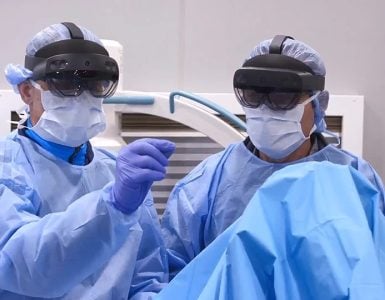Smith+Nephew has today announced the launch of its OR3O Dual Mobility System for use in primary and revision hip arthroplasty in Japan. Compared with traditional solutions, dual mobility implants have a small diameter femoral head that locks into a larger polyethylene insert – increasing stability, reducing dislocation risk, and offering improved range of motion.2
While most competitive devices utilize a Cobalt Chrome (CoCr) liner along with CoCr or ceramic head balls, OR3O incorporates Smith+Nephew’s latest advanced bearing surface, OXINIUM DH, for its liner and proprietary OXINIUM on XLPE for its femoral head and polyethylene inserts. This eliminates both the modular CoCr liner and/or CoCr head ball from the construct – reducing wear and corrosion risks that have been associated with the alloy.1
OXINIUM DH (Diffusion Hardened) is a unique variation of Smith+Nephew’s OXINIUM Technology platform that increases the depth of hardening through an additive manufacturing process.
The modular dual mobility segment was introduced to Japan in 2013 and has continued to grow globally. Post-operative dislocation is the second most common reason for revision of a total hip replacement globally3-6 and remains a serious concern for surgeons when performing total hip arthroplasty. Studies have shown dual mobility is uniquely positioned to manage dislocation, better than metal-on-metal or ceramic-on-ceramic large head series.7
“Smith+Nephew’s OR3O Dual Mobility System is a groundbreaking introduction for Japan that offers technology not available in competitive systems,” said Shinya Dobashi, Senior Vice President and Managing Director, North Asia, Smith+Nephew. “Over a dozen peer reviewed publications have now cited or expressed concerns over corrosion or elevated ions in CoCr modular dual mobility liners.8-20 The reduced corrosion1 of our OXINIUM and OXINIUM DH bearing surface sets OR3O apart from the competition.”
Smith+Nephew’s OR3O™ Dual Mobility System is available in Japan for both primary and revision applications and offers cross-compatibility with the R3™ Acetabular System.
References
- Parikh A; Pawar V; Sprague J. Long-term Simulator Wear Performance of an Advanced Bearing Technology for THA. Poster Presented at ORS. 2013; Poster No:1028
- Darrith B, Courtney P.M., Della Valle C.J. Outcomes of dual mobility components in total hip arthroplasty. Bone Joint J 2018;100-B:11–19.
- Australian Orthopaedic Association National Joint Replacement Registry (AOANJRR). Hip, Knee &
- Shoulder Arthroplasty: 2021: 2021 Annual Report, Adelaide; AOA, 2021: [Available at: https://aoanjrr.sahmri.com/annual-reports-2021]
- National Joint Registry for England, Wales and Northern Ireland, 18th Annual Report [Available at: https://reports.njrcentre.org.uk/downloads]
- American Joint Replacement Registry (AJRR), The Seventh Annual Report of the AJRR on Hip and Knee Arthroplasty 2021, American Academy of Orthopaedic Surgeons
- Italian Arthroplasty Register, Addendum to the Annual Report 2019, English Version of Tables and Figures, October 2020
- Boyer, B., Philippot, R., Geringer, J. & Farizon, F. (2011). ‘Primary total hip arthroplasty with dual mobility socketto prevent dislocation: a 22-year follow-up of 240 hips’, International Orthopaedics (SICOT) (2012) 36:511–518
- Spece, H., MacDonald, D. W., Mont, M. A., Lee, G.-C., and Kurtz, S. M., “Fretting Corrosion and Polyethylene Damage Mechanisms in Modular Dual Mobility Total Hip Arthroplasty,”Beyond the Implant: Retrieval Analysis Methods for Implant Surveillance, ASTM STP1606
- Nam,D., Salih,R., Nahhas,C., Barrack,R. And Nunley,R, (2019). ‘Is a modular dual mobility acetabulum a viable option for the young, active total hip arthroplasty patient?’, Bone Joint J 2019;101-B:365–371
- Matsen Ko,L., Pollag,K., Yoo,J., & Sharkey,P (2015). ‘Serum Metal Ion Levels Following Total Hip Arthroplasty With ModularDual Mobility Components’, The Journal of Arthroplasty 31 (2016) 186–189
- Civinini,R., Cozzi Lepri,A., Carulli,C., Matassi,F., Villano,M., & Innocenti,M. (2019). ‘Patients Following Revision Total Hip Arthroplasty With ModularDual Mobility Components and Cobalt-Chromium Inner MetalHead are at Risk of Increased Serum Metal Ion Levels’, The Journal of Arthroplasty 35 (2020) S294eS298
- Romero,J., Wach,A., Silberberg,S., Chiu,Y., Westrich,G., Wright,T., & Padgett,D. (2020) ‘2020 Otto Aufranc Award: Malseating of modular dual mobility liners; Incidence and Implications’ ,Bone Joint J 2020;102-B(7 Supple B):20–26
- Lee,G., Kamath,A. & Maxwell Courtney,P. (2020). ‘Clinical Concerns With Dual Mobility- Should I Avoid it When Possible?’, Article in Press, The Journal of Arthroplasty xxx (2021) 1e4
- Gkiatas,I., Sharma,A., Greenberg,A., Duncan,S., Chalmers,B. & Sculco,P. (2020). ‘Serum metal ion levels in modular dual mobility acetabular components: A systematic review’, Journal of Orthopaedics 21 (2020) 432–437
- Steven M. Kurtz et al. (2015) ‘Is There Material Loss at the Backside Taper in Modular CoCr Acetabular Liners?’, Clinical Orthopaedics and Related Research, 473:275–285
- Lombardo,D., Siljander,M., Gehrke,C., Moore,D., Karadsheh,M. & Baker,E. (2018). ‘Fretting and Corrosion Damage of Retrieved Dual-Mobility TotalHip Arthroplasty Systems’, The Journal of Arthroplasty 34 (2019) 1273e1278
- Kolz,J., Wyles,C., Van Citters,D., Chapman,R., Trousdale,R. & Berry,D. (2020). ‘In Vivo Corrosion of Modular Dual-Mobility Implants:A Retrieval Study’, The Journal of Arthroplasty 35 (2020) 3326e3329
- Sonn,K. & Meneghini,R. (2020). ‘Case report: Adverse Local Tissue Reaction due to Acetabular Corrosion in Modular Dual-Mobility Constructs’, Arthroplasty Today 6 (2020) 976e980
- Tarity,T., Koch,C., Burket,J., Wright,T. & Westrich,G. (2016). ‘Fretting and Corrosion at the Backside of Modular Cobalt ChromiumAcetabular Inserts: A Retrieval Analysis’, The Journal of Arthroplasty 32 (2017) 1033e1039
- D. C. Markel, T. Bou-Akl, M. D. Rossi, N. Pizzimenti, B. Wu, W. Ren (2019). ‘Blood metal levels, leucocyte profiles, and cytokine profiles in patients with a modular dual-mobility hip prosthesis: Early results from a prospective cohort study’, Bone Joint J 2019;101-B:1035–1041
Source: Smith+Nephew.











